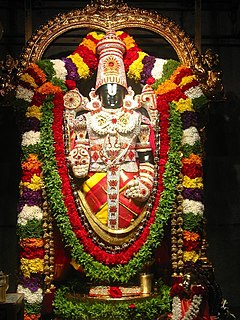
Lord Venkateshwara, also known as Śrīnivāsa, Bālājī, Vēṅkateswara, Venkata Ramana, Yedukondalavasa, Aapadamokkulavadu,Thirupathy Timmappa, Ezhumalaiyaan, Malaiyappa swamy and Govindha, is a form of the Hindu god Maha Vishnu. Lord Venkateswara is the presiding deity of Tirumala Venkateswara Temple located in Tirupati, Andhra Pradesh, India.

Bhairava is a Shaivite deity worshiped by Hindus. In Shaivism, he is a fierce manifestation of Shiva associated with annihilation. In Trika system Bhairava represents Supreme Reality, synonymous to Para Brahman. Generally in Hinduism, Bhairava is also called Dandapani and Swaswa meaning "whose vehicle is a dog". In Vajrayana Buddhism, he is considered a fierce emanation of boddhisatva Mañjuśrī and also called Heruka, Vajrabhairava and Yamantaka.
Kuruba, is a Hindu caste native to the Indian state of Karnataka, Andhra Pradesh and Telangana. They are the third-largest caste group in Karnataka. Traditionally, they were shepherds, militiamen from the hills, armed vassals, or postmen. They practiced sheep/goat and cattle pastoralism, in that they either herded exclusively sheep, or a mixed herd of sheep and goats, or cattle.
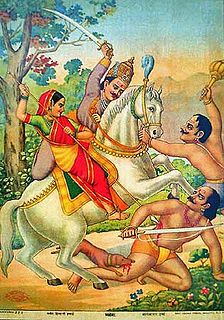
Khandoba, Martanda Bhairava,Malhari, or Malhar is a Hindu deity worshiped as a manifestation of Shiva mainly in the Deccan plateau of India, especially in the state of Maharashtra. He is the most popular Kuladaivat in Maharashtra. He is also the patron deity of select warrior, farming castes, Dhangar community and Brahmin (priestly) castes as well as several of the hunter/gatherer tribes that are native to the hills and forests of this region. The cult of Khandoba has linkages with Hindu and Jain traditions, and also assimilates all communities irrespective of caste, including Muslims. The worship of Khandoba developed during the 9th and 10th centuries from a folk deity into a composite god possessing the attributes of Shiva, Bhairava, Surya and Kartikeya (Skanda). He is depicted either in the form of a linga, or as an image of a warrior riding on a bull or a horse. The foremost centre of Khandoba worship is Jejuri in Maharashtra. The legends of Khandoba, found in the text Malhari Mahatmya and also narrated in folk songs, revolve around his victory over demons Mani-malla and his marriages.

The Jangam or Jangama are a Shaiva order of religious monks. They are the priests or gurus of the Hindu Shaiva sect. Jangamas are also gurus of Veershaiva' sect. Jangamas are disciples of Lord Shiva as mentioned in Basava Puranas. A visit of a jangam to a house is treated as the visit of Lord Shiva himself and the jangam shall be given good alms and the jangam blesses the natives. The Jangam is the wandering holy man in Virashaivism. The meaning of word Jangam is 'moving linga' and considered superioir to 'sthira linga'.
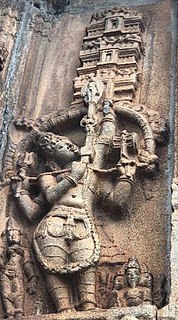
Tripurantaka or Tripurari is a manifestation of the Hindu god Shiva. In this aspect, Shiva is depicted with four arms wielding a bow and arrow, but different from the Pinakapani murti. He holds an axe and a deer on the upper pair of his arms. In the lower pair of the arms, he holds a bow and an arrow respectively. After destroying Tripura, Tripurantaka Shiva smeared his forehead with three strokes of Ashes. This has become a prominent symbol of Shiva and is practiced even today by Shaivites.
Kalyana Varadharaja Perumal Temple is an ancient temple that exists in Paruthiyur which is located at 31 Agraharam Street, Paruthiyur Via Sengalipuram, Thiruvarur District 612 604. When one enters the small village of Avanam Paruthiyur, on the banks of Kudamurutti river, a tributary of the Kaveri, the Paruthiyur Kalyana Varadharajar Temple is popular

Karnataka has a variety of traditional arts, including folk dance and puppetry.
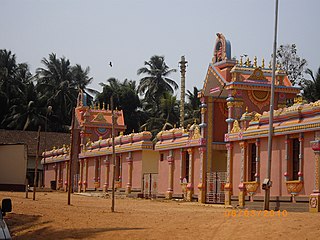
The Kudroli Shri Bhagavathi KshetraTemple is on a two-acre scenic plot in the heart of Mangalore in Karnataka. It is close to Hampankatta.
Sharanga is the celestial bow of the Hindu God Lord Vishnu. Other weapons of Vishnu include the Sudarshana Chakra, the Narayanastra, the Vaishnavastra, the Kaumodaki mace, Nandaka sword. In South India, Sharanga is also called as Kodanda. In poems written by Bhadrachala Ramadasu, the poet used words like Kodandapani to refer to Lord Rama. Even Mirabai referred to Lord Krishna as Kodandadhari.

The Mahabaleshwar Temple, Gokarna is a 4th-century CE Hindu temple located in Gokarna, Uttara Kannada district, Karnataka state, India which is built in the classical Dravidian architectural style. It is a site of religious pilgrimage. The temple faces the Karwar city beach on the Arabian Sea in which Hindu pilgrims cleanse before visiting the temple for worship. The temple is considered as holy as the Shiva temple at Varanasi or Kāśi (Kashi) in North India on the banks of the Ganges River. Hence, the Mahabaleshwar temple, Gokarna is known as the Dakshin Kasi. The temple deifies the Pranalinga also called Atmalinga or Shiva Linga In legend, it is said that the deity of the temple will bestow immense blessings to devotees, even to those who only glimpse it. Currently the administrative charge of the temple is with Sri Ramachandrapura Mutt, as per the guidance of Adiguru Shankaracharya during the establishment of the Matha.
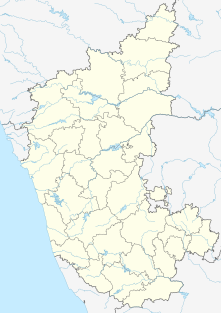
Shri Kuruvathi Basaveshwara temple at Kuruvathi is one of the ancient and historic temples at the extreme south-western corner of Hoovina Hadagali taluk, Bellary District, Karnataka, India. This temple is on the bank of Tungabhadra river, 10 km from Halavagalu and 2 km from Mylara and 36 km from Ranebennur and 326 km from Bangalore.
The Mylar Jaatre' is the biggest fair in Karnataka and one of the biggest in South India. More than 10 lakh devotees from all parts of the State and some neighbouring States congregate at Mylara, a pilgrim centre in Hadagali taluk, Bellary district, for the annual “Karnikotsava” (prophecy). The fair is celebrated every year at the local temple dedicated to Shiva in his form as Mailareshwara, the patron deity of the Kuruba Gowda community. Mylara is situated in the south-western corner of Hadagali taluk of the district, and is situated two km from Tungabhadra river and about 40 km from Hadagali town. It is believed that every year at Bharat hunnime, Elukoti with his wife Gangamalavva riding on a white horse will visit this place. People still experience thunder and lightning upon arrival of the God. This God believed to be a very fond of his bhaktas and will be pleased with Naivedya made of banana, sugar, ghee and milk mixed together.
Karnikotsava or prophecy is an ancient tradition followed by the Kuruba Gowda community of Karnataka. It is organised every year during the Mailara Jaatre in Bellary district of Karnataka. It is usually conducted in the month of February. The designated "Gorava," standing on top of a ten foot bow, prophesies what to expect in the coming year and lets himself down from that height to be caught by the devotees below. The Gorava, a follower of Mylara Lingeshwara, wearing a traditional overcoat of wool and headgear, traditionally fasts for the 11 days of the fair before prophesying on the penultimate day.
The term gorava refers to men and women belonging to the Kuruba community who have taken a special vow and dress in the traditional overcoat and headgear, and beat a damroo shouting "Elukoti.. Elukoti. Elukoti.", meaning seven crores - the number of Goravas Mailara, armed with a bow and arrows, took to battle against a demon, Mallasura and his brother. They also dance in ritualistic warrior-like dance called the Goravara Kunitha, which involves use of a small dollu in one hand and a flute in other. Goravas wear a headgear made of bear hair.

The Nanjundeshwara Temple is an ancient temple in the Hindu pilgrimage town of Nanjanagudu in the Karnataka state, Southern India. It is known for the ancient temple of the god Nanjundeshwara. The Nanjundeshwara temple is located in the town on the right bank of river Kapila, a tributary of the Kaveri. Nanjangudu is also known as "Dakshina Prayaga" or "Prayag of South".

Gajasurasamhara, also Gajasamhara, Gajantaka and Gajaha and Matangari, is a fierce aspect of the Hindu god Shiva as the Destroyer of the elephant demon, Gajasura. The icon is popular in Pallava and Chola art, which portray him dancing vigorously in the flayed elephant hide of Gajasura.

Sri Shiva Mailar Mallanna Temple is a Hindu temple dedicated to the god Khandoba. It is situated on the Bidar-Udgir Road, 15 km from Bidar, Karnataka, India. Said temple is located within the Vijayanagara ["city of victory"] empire; which is now South India. Some of the languages spoken during this time were Kannada, Telugu, and Tamil.

The Shree Vinayaka Devaru is a Hindu temple dedicated to the god Ganesha (Vinayaka), located on the West Coast of India in the Idagunji town in Uttara Kannada district in Karnataka state, India. The temple's popularity as a religious place is recorded by about 1 million devotees visiting it annually.
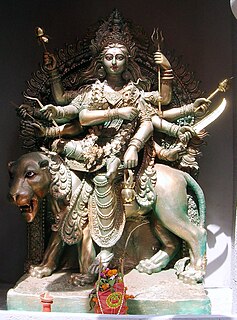
In Hinduism, Chandraghanta is the third form of Goddess Durga (Parvati). Her name Chandra-Ghanta, means "one who has a half-moon shaped like a bell. Her third eye is always opened and she always ready for war against demons". She is also known as Chandrakhanda, Chandika or Rannchandi. Her worship takes place on the third day of Navaratri. She is believed to reward people with her grace, bravery and courage. By her grace all the sins, distresses, physical sufferings, mental tribulations and ghostly hurdles of the devotees are eradicated. It also represent her married form.
















